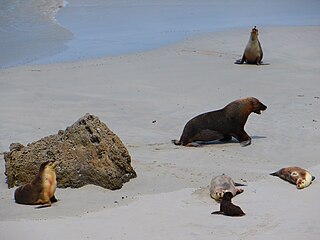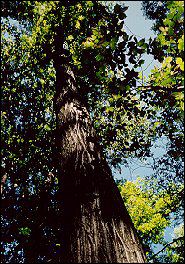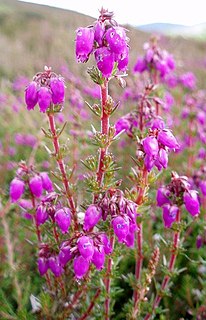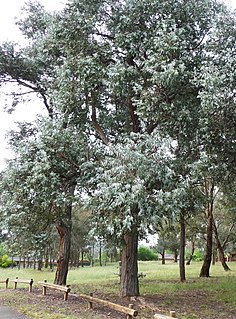
Botrytis cinerea is a necrotrophic fungus that affects many plant species, although its most notable hosts may be wine grapes. In viticulture, it is commonly known as "botrytis bunch rot"; in horticulture, it is usually called "grey mould" or "gray mold".

The grey heron is a long-legged predatory wading bird of the heron family, Ardeidae, native throughout temperate Europe and Asia and also parts of Africa. It is resident in much of its range, but some populations from the more northern parts migrate southwards in autumn. A bird of wetland areas, it can be seen around lakes, rivers, ponds, marshes and on the sea coast. It feeds mostly on aquatic creatures which it catches after standing stationary beside or in the water or stalking its prey through the shallows.

The grey wagtail is a member of the wagtail family, Motacillidae, measuring around 18–19 cm overall length. The species looks somewhat similar to the yellow wagtail but has the yellow on its underside restricted to the throat and vent. Breeding males have a black throat. The species is widely distributed, with several populations breeding in Europe and Asia and migrating to tropical regions in Asia and Africa. The species is always associated with running water when breeding, although they may use man-made structures near streams for the nest. Outside the breeding season, they may also be seen around lakes, coasts and other watery habitats. Like other wagtails, they frequently wag their tail and fly low with undulations and they have a sharp call that is often given in flight.

The Australian sea lion, also known as the Australian sea-lion or Australian sealion, is a species of sea lion that is the only endemic pinniped in Australia. It is currently monotypic in the genus Neophoca, with the extinct Pleistocene New Zealand sea lion Neophoca palatina the only known congener. These sea lions are sparsely distributed through Houtman Arbrolhos Islands in Western Australia and The Pages Islands in southern Australia. With a population estimated at around 14,730 animals, the Wildlife Conservation Act of Western Australia (1950) has listed them as “in need of special protection”. Their Conservation status is listed as endangered. These pinnipeds are specifically known for their abnormal breeding cycles, which are varied between a 5-month breeding cycle and a 17- to 18-month aseasonal breeding cycle, compared to other pinnipeds which fit into a 12-month reproductive cycle. Females are either silver or fawn with a cream underbelly and males are dark chocolate brown with a yellow mane and are bigger than the females.

Juglans cinerea, commonly known as butternut or white walnut, is a species of walnut native to the eastern United States and southeast Canada.

Erica cinerea is a species of flowering plant in the heath family Ericaceae, native to western and central Europe.

The American green tree frog is a common species of New World tree frog belonging to the genus Hyla. A common backyard species, it is popular as a pet, and is the state amphibian of Georgia and Louisiana.

Vitis cinerea, the graybark grape, is a variety of grape. It has small black berries that are mildly unpleasant to eat. Plentiful in Missouri and Louisiana, it is also found throughout the eastern half of the US as far west as Texas, north to Illinois, and south to Florida. It is also known by the name winter grape or possum grape.

Salix cinerea is a species of willow native to Europe and western Asia.

Coprinopsis cinerea is a species of mushroom in the family Psathyrellaceae. Commonly known as the gray shag, it is edible, but must be used promptly after collecting.

Gervais's fruit-eating bat is a bat species from South America. It is found in Brazil, French Guiana, Guyana, eastern Peru, Suriname and eastern Venezuela.
The Wych Elm cultivar Ulmus glabra 'Nigra', commonly known as the Black Irish Elm, was found in the Kilkenny area c.1770 by the father of nurseryman John Robertson of Kilkenny, who later cultivated it. Robertson stated that he had not seen the form outside Ireland. It was listed by Loddiges (1830) as Ulmus nigra, and described by Loudon in Arboretum et Fruticetum Britannicum (1838), as Ulmus montana nigra. 'Nigra' is not mentioned in either Elwes and Henry's or Bean's classic works on British trees.
The hybrid elm cultivar Ulmus × hollandica 'Cinerea' was first listed by George Lindley in 1815, as Ulmus cinerea, the Ash-coloured Elm, and later by the André Leroy Nurseries, Angers, France, in 1856. It was distributed as Ulmus cinerea by the Baudriller nursery, Angers, and as Ulmus montana cinerea by Louis van Houtte of Ghent. A specimen in cultivation at Kew in 1964 was found to be U. × hollandica, but the tree at Wakehurst Place remains listed as U. glabra 'Cinerea'.

Eucalyptus cinerea, commonly known as the Argyle apple or mealy stringbark, is a species of small to medium-sized tree that is endemic in south-eastern Australia. It has rough, fibrous bark on the trunk and branches, usually only juvenile, glaucous, egg-shaped leaves, flower buds in groups of three, white flowers and conical to bell-shaped fruit.

The bushy-tailed woodrat, or packrat is a species of rodent in the family Cricetidae found in Canada and the United States. Its natural habitats are boreal forests, temperate forests, dry savanna, temperate shrubland, and temperate grassland.

Dichrostachys cinerea, known as sicklebush, Bell mimosa, Chinese lantern tree or Kalahari Christmas tree, is a legume of the genus Dichrostachys in the Fabaceae family.
Vitis sinocinerea is a species of climbing vine in the grape family ranging widely over much of the Chinese mainland as well as Taiwan. In Chinese it is known as xiao ye pu tao, which can be translated as small-leaved grape. Its natural habitat is within forested or shrubby hills.

Sybra is a genus of beetles in the family Cerambycidae, containing the following species:

Sybra umbratica is a species of beetle in the family Cerambycidae. It was described by Pascoe in 1865.

Sybra ordinata is a species of beetle in the family Cerambycidae. It was described by Bates in 1873.



















